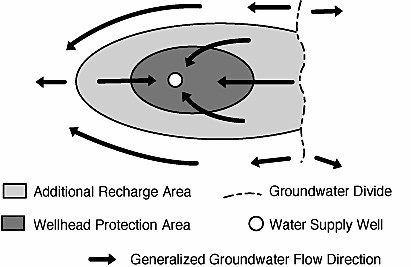How to develop a local program
Wellhead protection program
Source water and wellhead protection
- What are the steps in developing a wellhead protection plan?
- Forming a planning committee
- Delineating the wellhead protection area
- Inventorying potential groundwater contamination areas
- Managing the wellhead protection area
- Why should my community develop a wellhead protection plan?
- How can I get involved?
- What are the steps in developing a wellhead protection plan?
-
Your community can protect its water supply by taking the following steps:
- Forming a planning committee.
- Delineating the wellhead protection area.
- Inventorying potential groundwater contamination sources.
- Managing the wellhead protection area.
- Forming a planning committee
-
The first step is to form a committee to guide the plan development and implementation. Possible committee members could include representatives of the water utility; local health, fire, planning and zoning officials; farmers; business representatives; service organization representatives; elected officials, and interested citizens. It is important to take advantage of the knowledge and expertise that exists within your community to design a plan that will best meet the needs of your community.
The committee members can also be helpful in gaining public support for the wellhead protection effort. Educational efforts to involve the public and local media are important parts of the wellhead protection effort during the entire process.
- Delineating the wellhead protection area
-
Identify the recharge area – the land area which contributes
water to a well. -
The next step is to identify the recharge area, that is, the land area which contributes water to a well. Rain and snow falling within the recharge area will seep into the ground, move toward that well and eventually be pumped out of the well into that community’s water supply.
The community then needs to decide what area it will protect to prevent contamination of its wells. This area is the wellhead protection area (WHPA). Ideally, a WHPA would be the entire recharge area. Many times, however, the entire recharge area is too large to be managed effectively or it may lie partially outside the municipal boundaries.
The WHPA may be determined by a variety of methods, from a circle drawn at a calculated radius around the well to a complex groundwater model. DNR normally requires that the WHPA for a new well include at least that portion of the recharge area that contributes water within a five-year time of travel, with a minimum radius of 1200 feet around the well. Some communities square off the delineated area so that the WHPA boundaries are streets, rivers, railroad tracks or other easily recognizable landmarks.
- Inventorying potential groundwater contamination sources
-
Besides rain and snow, pollutants from a variety of activities on the land can seep into the ground and move toward your wells. A few of the many potential sources of pollutants are listed here. If not managed properly, all of the following can have an adverse effect on groundwater. Therefore, it’s important to inventory the existing and potential sources of groundwater contamination within the WHPA.
- Chemical storage
- Landspreading of sewage treatment plant sludges
- Road salt usage and storage
- Animal feedlots
- Use and spillage of fertilizers and pesticides
- Accidental spills
- Septic tanks and drainfields
- Underground storage tanks
- Underground pipelines and sewers
- Landfills
- Mines, pits and quarries
- Managing the wellhead protection area
-
Once the existing and potential sources have been identified, the final step is to take actions to minimize the potential for contamination of your community’s wells. Your community has a number of tools to manage the land around its wells and protect its wells from contamination. Some of the available options are adoption of zoning restrictions or ordinances, development of contamination contingency plans, working with facilities within the WHPA to minimize potential pollution problems, purchasing property around its wells and conducting a public educational program. View four good examples of local wellhead protection (WHP) ordinances [PDF] that have been adopted by Wisconsin communities. In deciding what management tools are appropriate, the community should assess the adequacy of existing programs to protect groundwater.
- Why should my community develop a wellhead protection plan?
-
- Wellhead protection is an investment in the future of your community. Your community can take a proactive step to reduce the potential for contamination of your community’s wells and to make your water supply safe for you and your children.
- Wellhead protection is a way your community can make its own decisions. Your community can tailor its wellhead protection plan to meet its specific circumstances.
- Wellhead protection is cost-effective. A modest investment in a wellhead protection program can save a community tens to hundreds of thousands of dollars by preventing contamination. If a well becomes contaminated, a community can be faced with costs to clean up groundwater, treat groundwater, drill a new well, provide an alternate source of water to its customers or some combination of actions. An ounce of prevention is truly worth a pound of cure.
- Wellhead protection assures a positive climate for economic growth. A community with an active WHP program can avoid the adverse economic impacts associated with a contaminated water supply, which might include a loss of jobs or a drop in real estate value.
- How can I get involved?
-
Contact your water utility and local officials and offer to help develop a wellhead protection plan.
Through your efforts, your community can develop and implement a program to protect your quality of life now and for future generations. You are the key to a successful wellhead protection program. Take the time to get involved. Your community can join over 200 other Wisconsin communities who have protected their water supply through wellhead protection planning.
Additional resources

